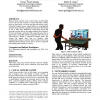Free Online Productivity Tools
i2Speak
i2Symbol
i2OCR
iTex2Img
iWeb2Print
iWeb2Shot
i2Type
iPdf2Split
iPdf2Merge
i2Bopomofo
i2Arabic
i2Style
i2Image
i2PDF
iLatex2Rtf
Sci2ools
ACMACE
2007
ACM
2007
ACM
Building a table tennis game for three players
Physical leisure activities such as table tennis provide healthy exercise and can offer a means to connect with others socially; however, players have to be in the same physical location to play. Networked computer games support players in geographically distant locations, but their communication channel is often limited to text or audio only. Furthermore, recent input devices that encourage exertion often do not support adequate force-feedback. We have developed a networked table tennis-like game that is played with a real paddle and ball, augmented with a large-scale videoconference. Similar to networked computer games, this concept can support more than two locations, while simultaneously aiming to provide similar benefits known from traditional physical leisure activity such as exercise, enjoyment and bringing people together to socialize. Categories and Subject Descriptors H5.2. Information Interfaces and presentation (e.g., HCI): User Interfaces. General Terms Human Factors, Des...
ACMACE 2007 | Human Computer Interaction | Networked | Physical Leisure | Physical Leisure Activities |
| Added | 12 Aug 2010 |
| Updated | 12 Aug 2010 |
| Type | Conference |
| Year | 2007 |
| Where | ACMACE |
| Authors | Florian Mueller, Martin R. Gibbs |
Comments (0)

